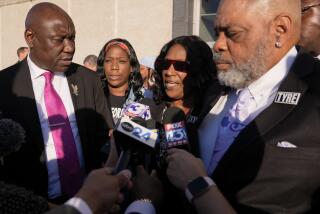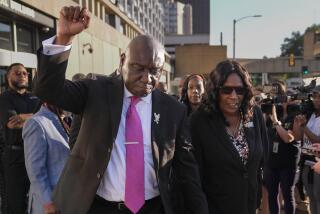In the city where Tyre Nichols was killed, some refuse to watch beating video that ‘exploits’ Black grief

- Share via
MEMPHIS, Tenn. — When it came time for Memphis officials to release graphic footage from the police beating of Tyre Nichols, Amber Sherman couldn’t stand to watch.
As the video was being released at 6 p.m. Friday, Sherman and other protesters gathered outside the headquarters of the Memphis police’s organized crime unit, then headed south, reaching a highway and blocking a major bridge. Shouting into a bullhorn, she told the other protesters that they didn’t need to see the images because they already knew what they showed:
Pain. Terror. Helplessness. The sight of yet another Black body writhing under the blows of police fists and boots.
The shaky video of the Jan. 7 traffic stop in southeast Memphis sparked a national outcry. Local community leaders and President Biden condemned the actions of the five officers who dragged the 29-year-old Nichols from his car, punching, kicking, pepper-spraying and using a Taser on him as he pleaded for them to stop. He died at a hospital three days later. A spokeswoman for the city said the recording had 1.7 million views within 17 hours of its release.
But Sherman and others in this Southern city of 600,000 who refused to watch the footage saw the images as exploiting Black trauma. In the era of police body cameras and smartphones, Americans have seen enough violence and brutality by law enforcement to know what the Nichols recording would show, said Sherman, an organizer with Black Lives Matter-Memphis.
“I think the need to watch someone be murdered is really around the spectacle of death and how we objectify Black people and their bodies and how we don’t see their humanity,” said Sherman, who has emerged as a prominent voice in the protests that followed Nichols’ death. “I think that just removes the humanity from us and continues to objectify us, and I think that’s one of the main reasons that police treat us like dogs in the streets.”
For Sherman, the decision to not watch the video was as much a necessary act of self-care as it was a political statement. But she also recognized the need for others to bear witness to police brutality, recognizing the raw power these images have in jolting the collective consciousness and effecting social change.
After all, she said, much of white America didn’t fully realize the brutality of law enforcement in Black and Latino neighborhoods until the video of Los Angeles police beating Rodney King during a traffic stop in 1991 became public.
Before then, Sherman said, those victims of police violence were widely ignored.
“If a Black person says that, we only believe it if: one, there’s a death; two, if there’s video; and three, if there’s witnesses,” she said.
But Sherman’s decision to avoid the traumatizing images herself was endorsed on social media, which was filled with commentary about the need for collective healing and the right of Black people to grieve privately when tragedy strikes.
More than any other high-profile police killing in recent memory, the Nichols recording — compiled from various forms of video, including body camera footage and pole camera images — was widely anticipated, inspiring dread.
Memphis officials said early last week that the release would be Friday. Some residents in a city synonymous with blues music and the civil rights movement feared a repeat of the large-scale protests that followed the acquittal in 1992 of the officers in King’s beating. The FBI issued a warning to local law enforcement agencies around the country to be on alert for potential unrest, while some school districts canceled after-school activities and businesses shut down early.
For several days, the city held its breath.
Adding to the anxiety were comments by senior law enforcement leaders who had seen the images and described them as “heinous” and “absolutely appalling.” Lawyers for the Nichols family, which also previewed the footage, told reporters that officers were seen treating Nichols like “a human piñata” and compared it to the recording of King — only in higher definition.
Attorney Benjamin Crump said Nichols’ family agreed to investigators’ request to wait a week or two before making the recording public to “make sure to give this family what they want most, and that is justice.” Nichols’ mother, RowVaughn Wells, said that she had been unable to finish watching the video, and encouraged parents everywhere to keep their children from seeing it. She asked that those who protest do so peacefully.
Some observers credited officials’ decision to release the videowith helping defuse violent protests. And police Chief Cerelyn “CJ” Davis — who became the city’s first Black female top cop after taking the job in 2021 — also drew praise in some quarters for firing the five officers most directly involved in Nichols’ beating.
The officers — Tadarrius Bean, Demetrius Haley, Emmitt Martin III, Desmond Mills Jr. and Justin Smith — were indicted on various criminal charges, including second-degree murder. They were released from the Shelby County Jail early Friday morning after posting bond, according to jail records.
Several hours after the video’s release, Jerry Torres, 22, was one of several people who’d stopped by to pay their respects at the spot where Nichols was taken into custody. After pulling him over for unclear reasons, officers chased Nichols for nearly half a mile to a cul-de-sac of tidy brown brick buildings down the street from his mother’s house.
Torres said he felt that as difficult as it was, people should watch the video of the beating so that they could grasp the horror of what happened to Nichols.
“The only reason that people are out here is because of the body cam footage and that’s the only reason that people really know where the incident happened,” he said.
The next day, roughly 200 people gathered under a light rain outside the city’s Public Safety Building before marching through downtown. Walking several yards behind the main group, Frank Gibson, a local activist known as “Frank Gottie,” said he pulled the video of the beating up on his laptop, but had to turn it off after about 30 seconds.
“That was enough. Five seconds of it was enough,” he said. “I seen how they ran up on him like in football; he kicked him like he was kicking a field goal.”
Theodore Martin, 51, said he knew some people, including his sister, who refused to watch the video. But, he said, even though he doubted that the actions of police would surprise him, he still wanted to see it.
“I’m just curious, was this man handcuffed and all that, you know why’re they doing all this to him,” said Martin, 51, who was sitting on a four-wheeler outside a home in the New Chicago neighborhood in North Memphis. A friend he was chatting with, OJ Phillips, 62, nodded. “Some people said they can’t stand to watch it,” Martin said.
Research has shown that viewings of Black people dying at the hands of law enforcement can be psychologically and emotionally harmful for other African Americans, according to Duane Loynes Sr., an assistant professor of urban and Africana studies at Rhodes College in Memphis. Nichols’ anguished cries for his mother during the beating are likely to trigger traumatic memories in the minds of Black Memphians, many of whom had grown up on a hard lesson: Running from the police often results in a beating.
For many, he said, it was enough to hear a description of what happened.
“These realities are not new to Black residents in Memphis or many communities around the United States, and so for a lot of people it’s like, ‘Why would I watch something so brutal and violent when I’ve lived this reality?’” said Loynes, whose research focuses on the relationship between Black communities and police. “For some people, they didn’t watch this video, because they lived this reality, because it’s going to bring a great amount of stress and anxiety.”
Similar images of Black bodies being brutalized, at the hands of police or other civilians have in the past sparked strong condemnations from elected officials, but rarely led to lasting changes in the real world. Not even three years ago, a video of George Floyd dying under the knee of a Minneapolis police officer sparked widespread protests and a reckoning over racial injustice, he said. But most cities have fallen far short of the radical changes to policing that many advocated for in the wake of Floyd’s murder, he said.
“For every Tyre Nichols, I guarantee you already in the month of January that are many other [similar incidents] we will never hear about. And so, will that change America? I’m not so sure,” Loynes said. “If we don’t learn our lessons, we’ll be here again, the next city, the next state.”
By Sunday, a sense of normality had returned to parts of the city.
At the morning service at First Baptist Church Broad, guest Pastor Eric Givens’ sermon was about the biblical story of Elijah and its lessons about the power of prayer and trusting God’s plan at the cost of great personal sacrifice. As Givens’ voice thundered through the large church auditorium, some churchgoers stood to clap or swayed with arms outstretched to the sky.
When he finished, the congregants gathered their belongings and prepared to march through the surrounding neighborhood.
More to Read
Sign up for Essential California
The most important California stories and recommendations in your inbox every morning.
You may occasionally receive promotional content from the Los Angeles Times.











